In today’s competitive business landscape, effective content marketing plays a crucial role in establishing a company’s thought leadership and driving business growth. Gong, a leader in sales conversation intelligence, has successfully utilised content marketing to achieve remarkable success in the industry. This article explores Gong’s content marketing success story, delving into its strategy, achievements, and key takeaways that other companies can replicate.
How did gong generated its huge organic traffic?
Gong’s content marketing campaign has been instrumental in establishing the company as a thought leader in the B2B sales industry. By consistently delivering high-quality and insightful content, Gong has attracted a significant following and achieved notable success.
It positions itself as an industry expert in conversation analytics and sales effectiveness. Their content showcases deep knowledge of the sales process, including topics like sales coaching, sales performance, deal execution, and data-driven sales strategies.
Some of Gong’s key achievements include substantial growth in website traffic, lead generation, and social media engagement. Through their content marketing efforts, Gong has effectively captured the attention of their target audience, resulting in increased brand visibility, credibility, and customer acquisition.
Here, monthly visits from organic search are estimated to be around 40.7k, with the highest traffic coming in from the United States. (Source: Ahrefs). Their website traffic reached over 1M in the last few months.


Gong's content marketing strategy
Gong’s content marketing strategy encompasses a multi-faceted approach, encompassing various types of content, distribution channels, and a well-defined target audience.
The website:
One thing that stands out the most when one first visits their homepage–the interactive UI, subtle yet attractive animations, and vibrant colour scheme. What most companies overlook is this one factor, the first impression on organic visitors, which makes them stay and increases lead conversion. Also, as we scroll down, the CTAs are pinned to the top of the screen, compelling the visitor to take the demo or simply take a tour of the rest of their website and platform– all in exchange for your email, where they can market their content.

Types of content:
Gong.io creates a wide range of content to engage and educate its target audience. Their content includes blog posts, eBooks, whitepapers, videos, podcasts, webinars, and case studies. By diversifying content formats, they cater to different preferences and learning styles.
Let us understand some of the content type in detail:

a) The resources hub
This can be navigated via the reader’s specific goals and problems, from revenue growth to leadership. If the visitor doesn’t know what they are looking for (like a specific guide or template), the Resources Hub is the one-place-has-it-all webpage.
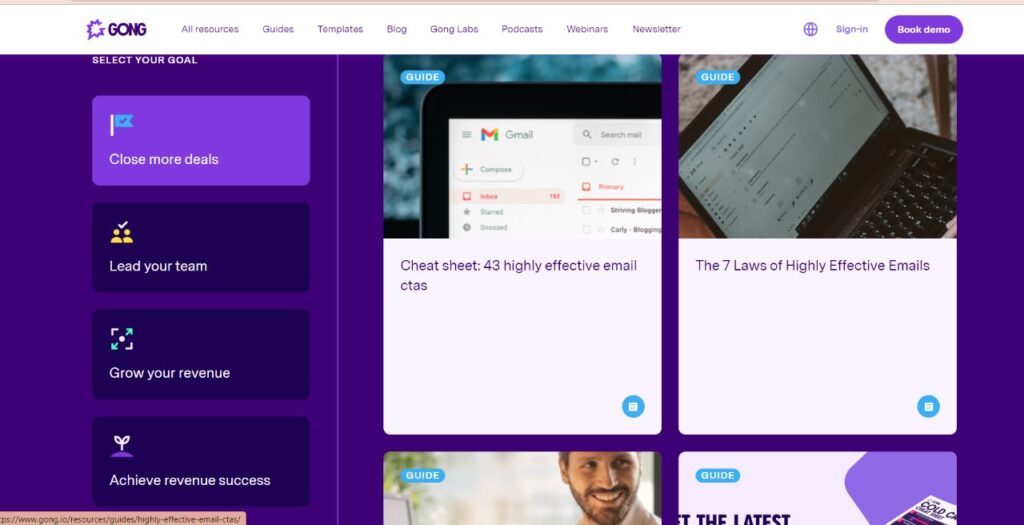
b) The podcast
Has an entirely separate landing page and name, featuring experts from LinkedIn, Netflix, Amazon, etc. on the other side of the mic. The options at the top-right corner direct to the original site. Each podcast is approximately 30 minutes long and is in video format.
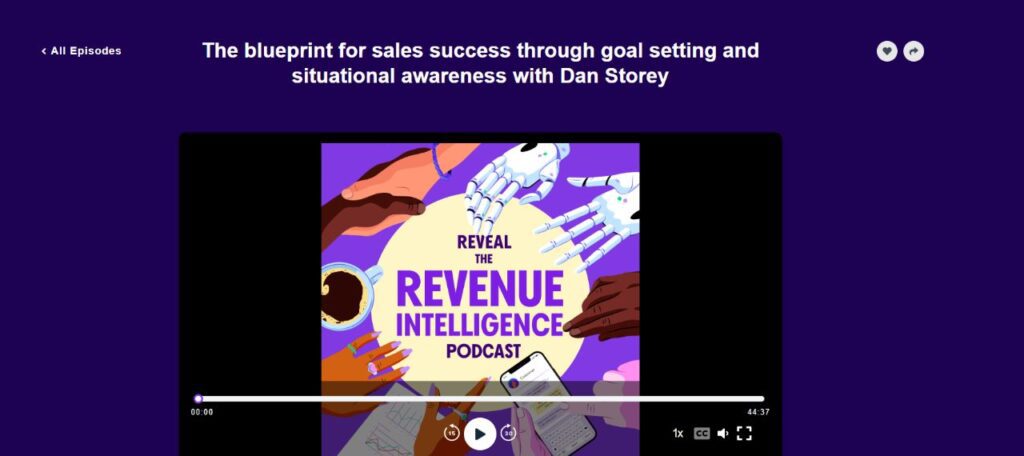


c) The newsletter (Edge)
Another page with a compelling tagline— “designed uniquely for growth-minded readers” and features like 5-minute reads only once a month because nobody likes being spammed! The information is credible, as they publish insightful and data-driven content. They conduct research and collect data from their conversation analytics platform to provide unique insights into sales trends, best practices, and benchmarks. This approach establishes Gong.io as a trusted source of information in the sales industry.
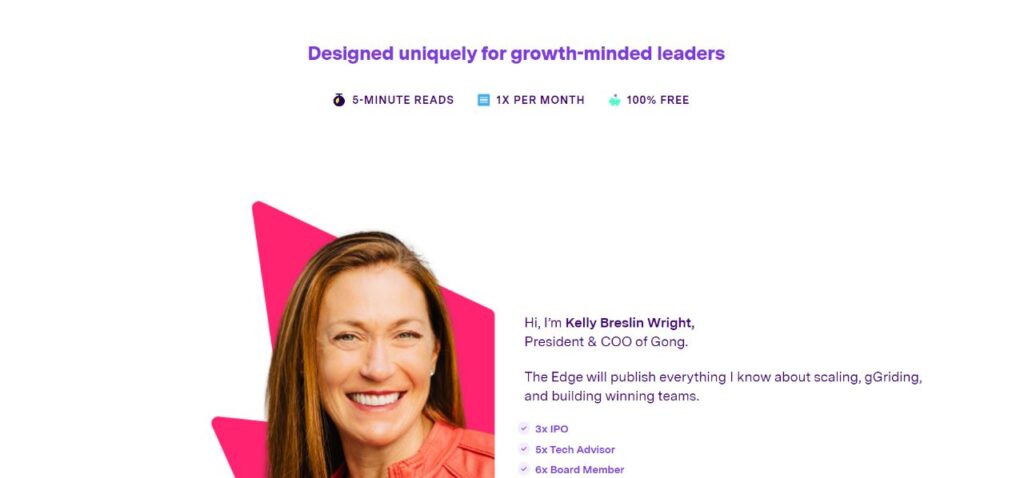
Why is it called The Edge? Because that’s what it promises. An edge over everyone else, a competitive advantage with every new edition.
d) Blog posts
Gong’s blog serves as a hub for its thought leadership content. They cover various topics related to B2B sales, including sales strategies, leadership, customer experience and success, revenue intelligence, sales enablement, and sales management as well as industry trends. Blog posts allow Gong to provide in-depth analysis, share insights, and engage with their audience through comments and discussions.
Additionally, Whitepapers and eBooks: Gong produces in-depth research reports, whitepapers, and eBooks that provide valuable insights into the sales industry. These resources often include data-driven analysis, case studies, and actionable tips. Gong positions itself as an expert and thought leader in the field by offering in-depth knowledge and actionable advice.
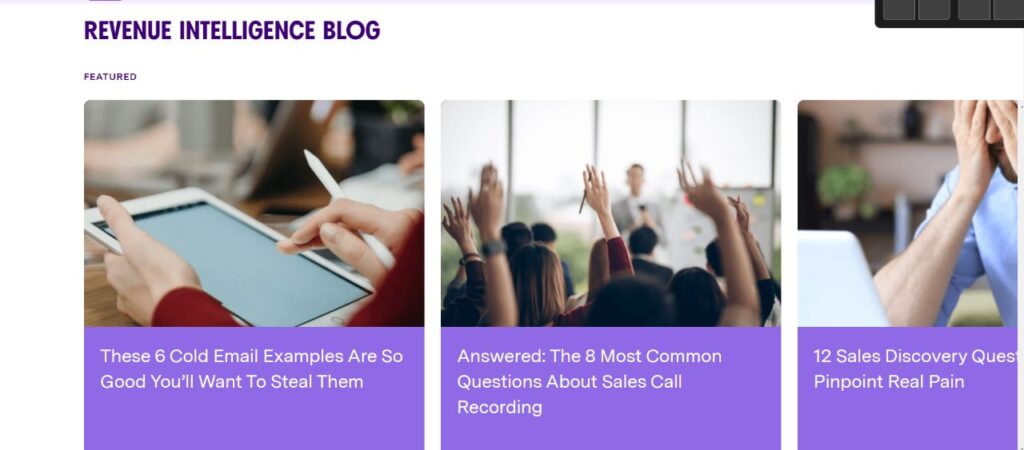
e) Other content
This includes questionnaires to test your Revenue IQ (free tool)
When a person takes this survey they are asked questions about their teams, deals, and market. Based on this they are assessed and given a score for each of these categories and overall across all.
It then gives you a score and a label. The labels are:
- Emerging
- Developing
- Transforming
- Transcending
Then Gong asks for your work email access to the results.
Gong is a revenue intelligence platform that helps sales teams improve their performance through data-driven insights. Gong has utilized various content distribution strategies to reach its target audience.
These are some common strategies used by gong for content distribution:
a) Target audience:
Gong has a clear understanding of their target audience and primarily targets sales and revenue professionals, including sales managers, sales representatives, and sales enablement teams. They focus on industries such as technology, SaaS, and B2B sales. Their content is tailored to address the challenges, and trends relevant to this specific audience. This customer-centric approach has helped them resonate with their target audience and establish themselves as a valuable resource within the industry.
b) Multi-channel strategy:
Gong.io leverages various distribution channels to reach its target audience. They share their content on their website, blog, and resource library. Additionally, they have a strong presence on social media platforms like LinkedIn, Twitter, and YouTube, where they share content and engage with their audience.
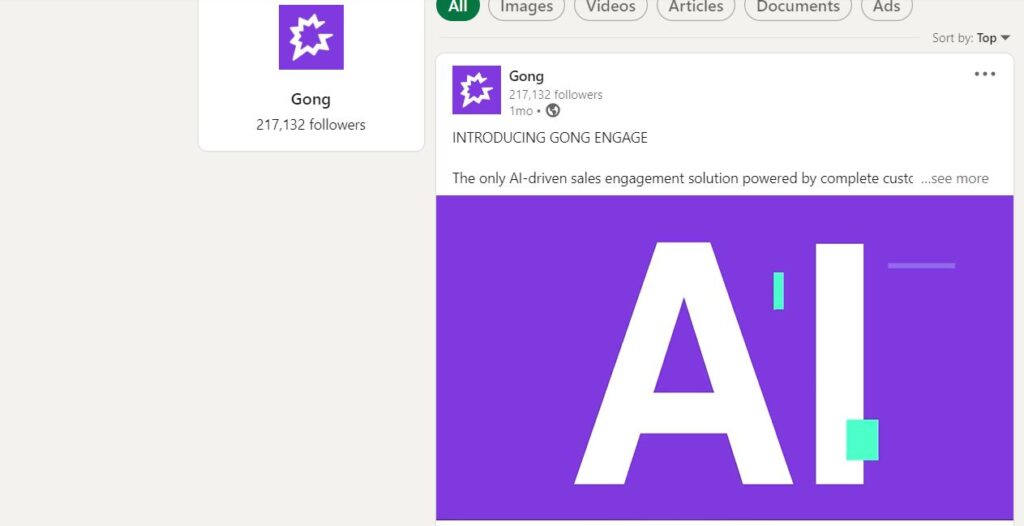
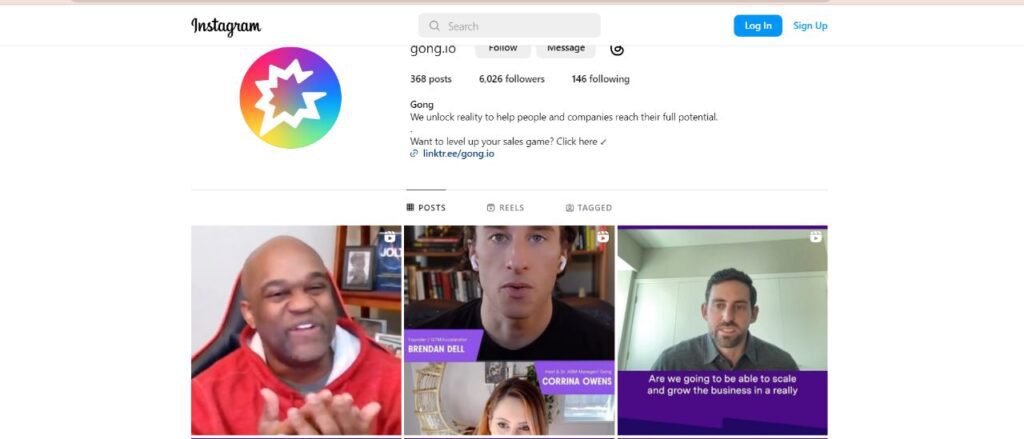
c) Influencer collaborations:
Gong.io collaborates with influential figures in the sales and marketing industry. They invite guest authors, industry experts, and sales leaders to contribute to their blogs, podcasts, and webinars. This strategy helps them tap into a wider audience, enhance credibility, and create valuable networking opportunities.

d) Industry events and webinars:

Gong actively participates in industry events, conferences, and webinars. They leverage these opportunities to share valuable insights, present case studies, and engage with a live audience. This not only expands their reach but also positions Gong as an industry leader.
e) Guest posting along with independent articles:
Gong collaborates with industry publications and influential websites to publish guest posts. By sharing their expertise on reputable platforms, Gong reaches a wider audience and establishes credibility within the industry.
With success and popularity over the years, independent writers have also seemed to publish ‘reviews’ about the business:
An Unbiased Look at Gong
Replicating gong's success
Based on Gong’s content marketing success, here are practical tips for companies looking to replicate their achievements:
Gong.io is a company known for its effective content marketing strategy. To help similar companies utilize a similar approach, here is a step-by-step plan based on Gong.io’s content marketing strategy:
Step 1: Define your target audience and diversify
Step 2: Set clear goals and objectives
Step 3: Conduct in-depth research
Step 4: Develop a content plan
Step 5: Create high-quality, valuable content
Step 6: Optimize for SEO
Step 7: Leverage multiple channels
Step 8: Engage with Your audience
Step 9: Measure and analyze the results
Step 10: Iterate and improve.
Let us understand each of the steps in detail:
Step 1: Define your target audience and diversify
- Clearly identify your target audience, including their demographics, needs, pain points, and preferences.
- This will help you create content that resonates with them and drives engagement. Create different types of content to cater to your audience’s preferences.
- From guides and templates to blogs, podcasts, and webinars, offer a variety of formats to keep things interesting.
Step 2: Set clear goals and objectives
- Establish specific goals and objectives for your content marketing strategy.
- Whether it’s generating leads, increasing brand awareness, or positioning your company as a thought leader, make sure your goals are measurable and aligned with your overall business objectives.
- Group that content with what your audience wants to achieve.
- Gong does this by categorizing resources for specific goals like closing deals, leading teams, and growing revenue. It makes it easier for people to find relevant content.
Step 3: Conduct in-depth research
Perform thorough research to understand your industry, competitors, and target audience better.
- This includes analyzing competitor content strategies and conducting surveys or interviews with your target audience to gain valuable insights.
- Use data and insights to support your content.
- Whether it’s analyzing your own data or industry trends, providing valuable resources backed by data helps your audience make better decisions.
Step 4: Develop a content plan
Create a comprehensive content plan that outlines the types of content you’ll create, the platforms you’ll use, and the frequency of content production.
- Consider using a mix of formats such as blog articles, videos, infographics, podcasts, and social media posts to cater to different preferences and increase your reach.
- Usually, a month-long content plan in advance is what most companies follow.
Step 5: Create high-quality, valuable content
- Focus on producing high-quality, valuable content that addresses your audience’s pain points, answers their questions, and provides unique insights.
- Ensure that your content is well-researched, well-written, and visually appealing to capture and retain your audience’s attention.
- Creating a Central Content Hub on your website where people can easily access all your content can help, like Gong’s Resources Hub.
- It’s like a one-stop shop for your audience to find what they need. The content doesn’t just need to be available, it should also be easily accessible.
Step 6: Optimize for SEO
Implement search engine optimization (SEO) techniques to make your content more discoverable.
- Conduct keyword research to identify relevant keywords and incorporate them naturally into your content.
- Optimize meta tags, headers, and URLs to improve your content’s visibility in search engine results.
- The website should be able to make the visitor stay, loading should be minimal at best, and it should have a mobile-friendly design.
- While Gong uses paid and branded keywords like “Gong”, “Gong.io”, and “Conversational Intelligence Tools”, most of its traffic comes in organically which just proves how hard they have worked on creating a spot for themselves on the web.
Step 7: Leverage multiple channels
Promote your content across various channels to maximize its reach.
- This includes sharing your content on your website, blog, social media platforms, email newsletters, and industry-specific forums or communities.
- Tailor your content for each channel to ensure it aligns with the platform’s format and audience preferences.
- Don’t let your content go to waste. Repurpose it for different platforms.
- Turn podcast episodes into bite-sized clips for Instagram or YouTube.
- Reach a wider audience and get the most out of your content.
Step 8: Engage with your audience
- Encourage interaction and engagement with your content by enabling comments, responding to comments and messages promptly, and actively participating in discussions related to your content.
- This helps build a community around your brand and establishes you as an authority in your industry.
Step 9: Measure and analyze results
- Regularly track and analyze key metrics to assess the effectiveness of your content marketing efforts.
- Monitor metrics such as website traffic, engagement levels, social media shares, lead generation, and conversion rates.
- Use this data to identify what’s working well and make data-driven adjustments to your strategy.
Step 10: Iterate and improve
- Based on your analysis, refine and optimize your content marketing strategy continuously.
- Experiment with different content formats, topics, and distribution channels to find what resonates best with your audience.
- Stay up to date with industry trends and adapt your strategy accordingly to maintain a competitive edge.
Remember, Gong.io’s success is the result of its unique approach tailored to its specific industry and target audience. While this step-by-step plan is based on their strategy, it’s crucial to adapt and customize it to fit your company’s unique needs and goals.
Conclusion
Gong’s success in the industry as a leader in sales conversation intelligence is closely tied to its content marketing strategy. By producing valuable and insightful content, targeting its audience effectively, and leveraging multiple distribution channels, Gong has established itself as a thought leader and achieved remarkable growth. Their strategic distribution across platforms such as their website, social media, email newsletters, guest posts, industry events, and podcasts ensures maximum visibility and engagement with their target audience.


